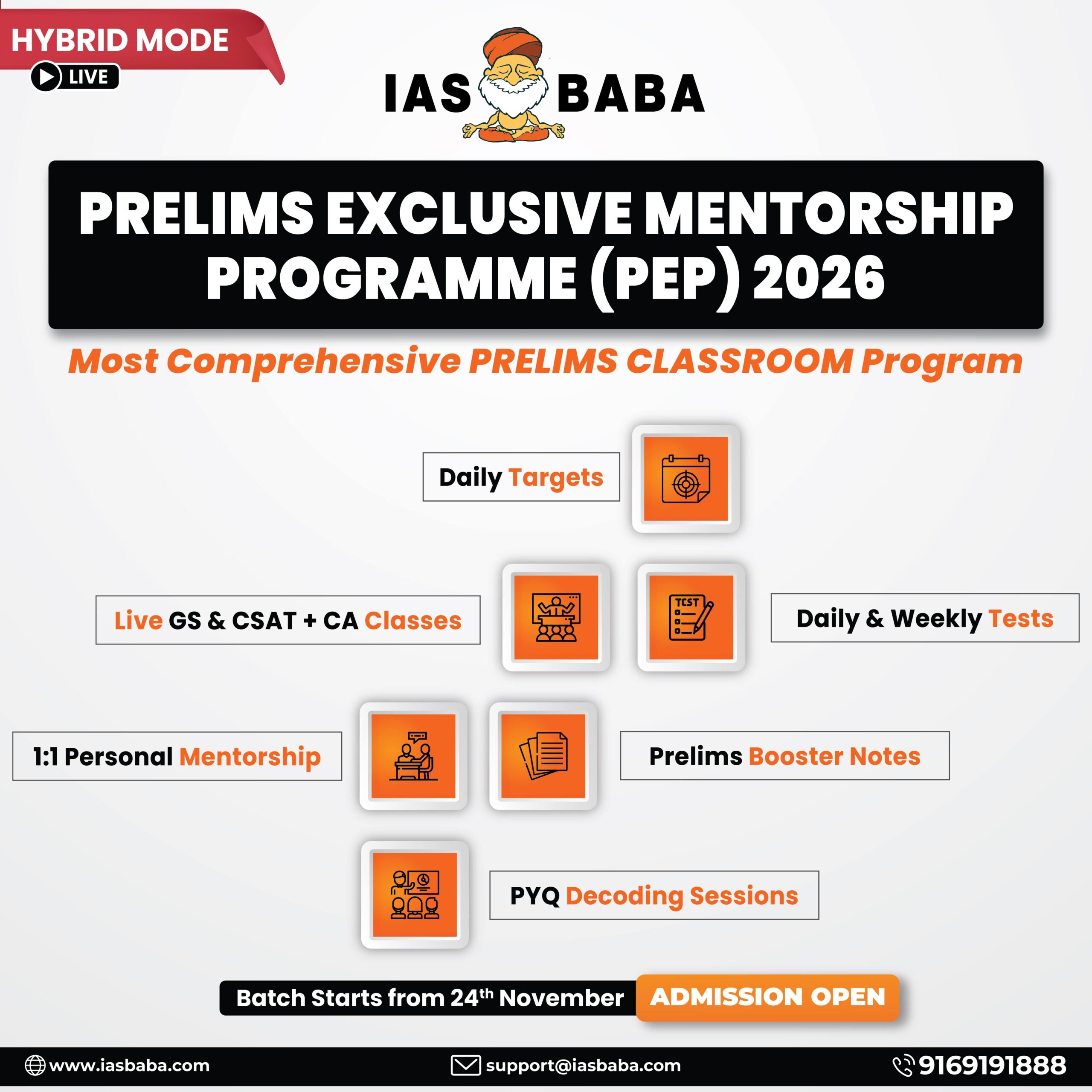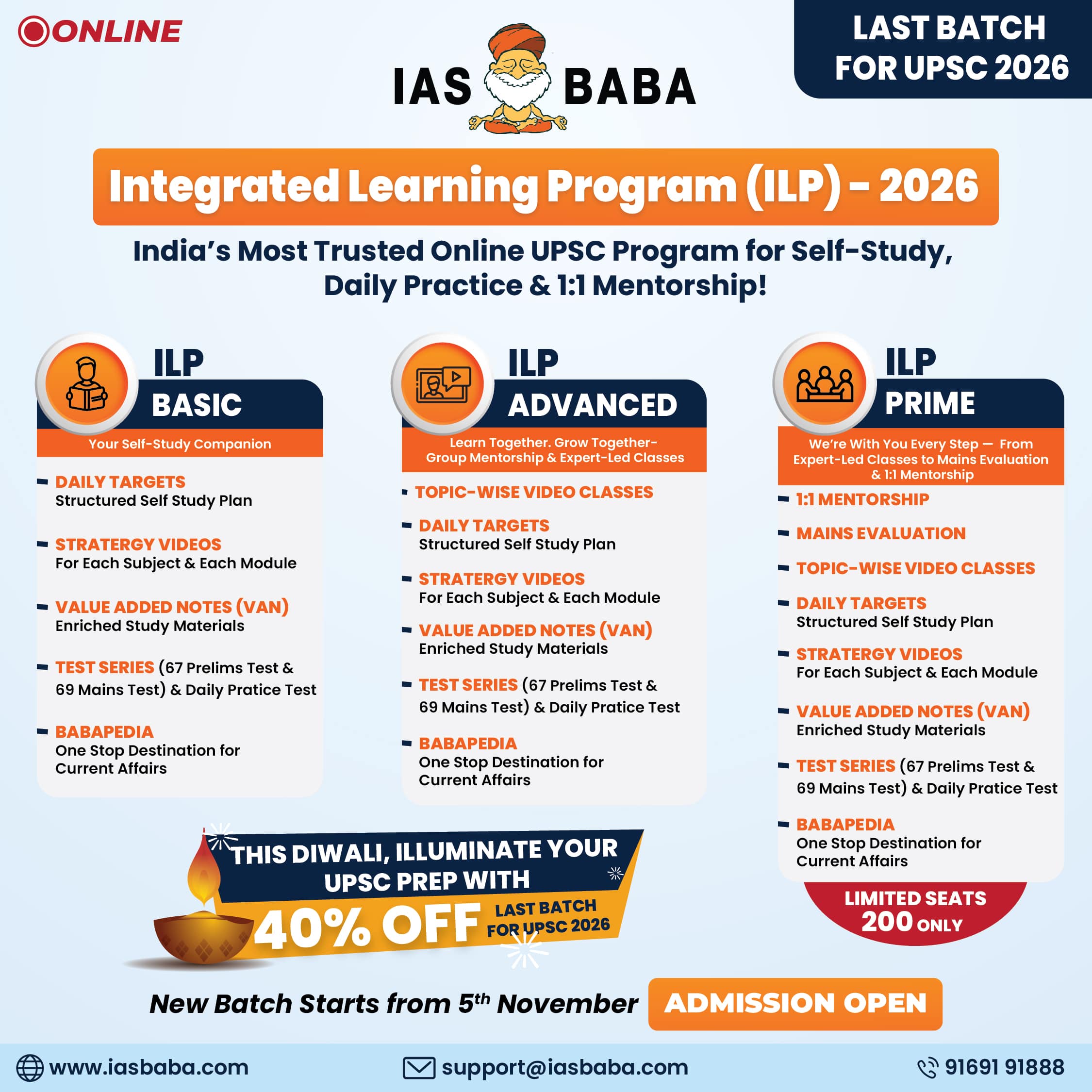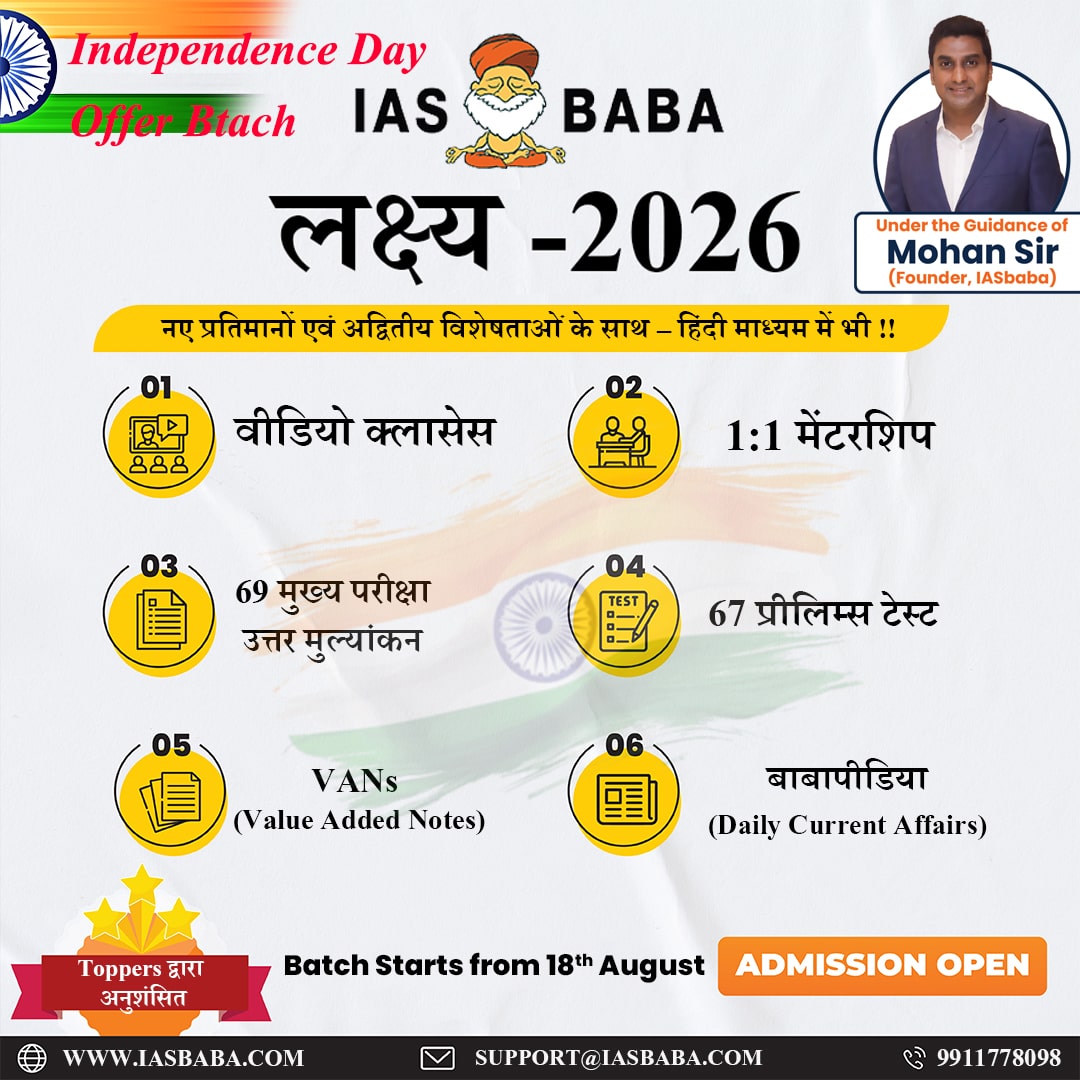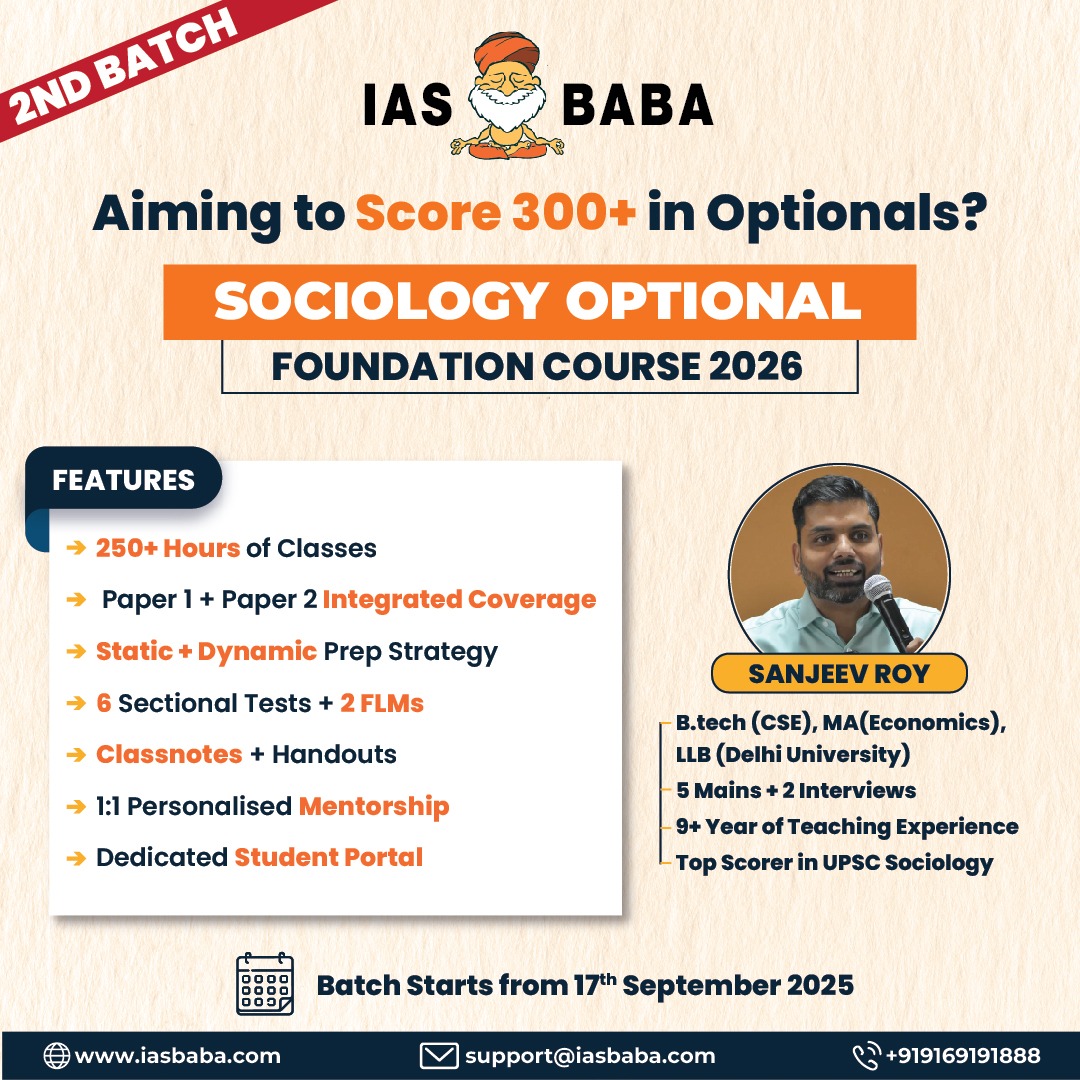IASbaba's Daily Current Affairs Analysis
Archives
(PRELIMS Focus)
Category: POLITY
Context: The Election Commission of India (ECI) has initiated steps to de-list 345 Registered Unrecognised Political Parties (RUPPs) that haven’t contested elections in the last six years and whose offices could not be physically located.
Decoding the context:
What is a Registered Political Party?
- Forming associations, including political parties, is a fundamental right under Article 19(1)(c) of the Constitution.
- Section 29A of the Representation of the People Act (RPA), 1951 governs party registration.
- Within 30 days of formation, parties must submit their memorandum/constitution to the ECI.
- Must declare allegiance to the Constitution and uphold sovereignty, democracy, etc.
Benefits of RUPP Status:
- Eligible for:
- Income tax exemptions (under Section 13A of IT Act).
- Common election symbol.
- Donations and campaign funding benefits.
Why are parties being de-listed?
- 345 RUPPs haven’t contested elections since 2019 and can’t be physically traced.
- These are considered ‘inactive’ and ineligible for tax benefits and candidate nomination.
- The ECI directed State Chief Electoral Officers to issue show-cause notices before de-listing.
What else needs attention?
- Over 1000 ‘active’ RUPPs may also not have contested elections recently.
- Law Commission (255th Report, 2015) and ECI (2016 reforms memo) had recommended:
- De-registration if a party fails to contest elections for 10 consecutive years.
- However, there is no explicit power under current laws for the ECI to de-register parties.
- Legal amendments to the RP Act may be needed for such powers.
Learning Corner:
Election Commission of India (ECI)
The Election Commission of India (ECI) is an autonomous constitutional authority responsible for conducting free and fair elections in India.
Constitutional Status:
- Established under Article 324 of the Indian Constitution.
- Came into force on January 25, 1950 (celebrated as National Voters’ Day).
Functions of ECI:
- Conducts elections to:
- Lok Sabha and Rajya Sabha
- State Legislative Assemblies and Councils
- President and Vice President of India
- Prepares and updates electoral rolls
- Recognizes political parties and allots symbols
- Enforces the Model Code of Conduct
- Monitors election expenditures and ensures transparency
Composition:
- Originally a single-member body (Chief Election Commissioner)
- Since 1993, it is a multi-member body:
- Chief Election Commissioner (CEC)
- Two Election Commissioners
Tenure and Removal:
- Appointed by the President of India
- Tenure: 6 years or up to the age of 65, whichever is earlier
- CEC can be removed like a Supreme Court judge (through impeachment)
- Other Election Commissioners can be removed on the recommendation of the CEC
Significance:
- Ensures democratic integrity through impartial election processes
- Acts as a watchdog of democracy and a protector of electoral rights
Source: THE HINDU
Category: ECONOMICS
Context: In its Spring/Summer 2026 menswear collection, Prada featured sandals closely resembling Kolhapuri chappals, traditional handcrafted leather footwear from Maharashtra and Karnataka with a Geographical Indication (GI) tag
Key Issues:
- Cultural Appropriation: The design was used without recognizing its Indian heritage or the artisans behind it.
- Economic Disparity: While authentic Kolhapuris are sold for around ₹500, Prada’s version was priced above ₹1 lakh, highlighting the imbalance in profits and credit.
- Weak Legal Enforcement: Despite GI protection, there is limited legal recourse against global misuse, exposing gaps in international IP law.
- Artisan Marginalization: The incident reflects ongoing neglect of traditional craftsmen in global markets.
Learning Corner:
Geographical Indication (GI) Tag
A Geographical Indication (GI) is a sign used on products that have a specific geographical origin and possess qualities, reputation, or characteristics inherent to that location. It is a form of intellectual property right (IPR) governed in India by the Geographical Indications of Goods (Registration and Protection) Act, 1999.
- Administered by: Geographical Indications Registry under the Controller General of Patents, Designs and Trade Marks.
- Legal protection: Prevents unauthorized use by others not belonging to the geographical region.
- Validity: Initially for 10 years, can be renewed indefinitely.
- Benefits:
- Protects traditional knowledge and skills.
- Helps local artisans, farmers, and producers gain premium value in markets.
- Promotes rural economic development and preserves cultural heritage.
Tagged Products in India
| Product | State of Origin |
|---|---|
| Kolhapuri Chappal | Maharashtra & Karnataka |
| Darjeeling Tea | West Bengal |
| Mysore Silk | Karnataka |
| Pochampally Ikat | Telangana |
| Banarasi Saree | Uttar Pradesh |
| Kanchipuram Silk Saree | Tamil Nadu |
| Aranmula Kannadi (mirror) | Kerala |
| Bhut Jolokia (Chili) | Assam |
| Alphonso Mango | Maharashtra |
| Basmati Rice | Punjab, Haryana, UP, etc. |
| Lakadong Turmeric | Meghalaya |
| Vasmat Haldi (Turmeric) | Maharashtra |
| Uttarakhand Lal Chawal (Red Rice) | Uttarakhand |
| Khamti Rice (Khaw Tai) | Arunachal Pradesh |
| Agassaim Brinjal | Goa |
| Borsuri Tur Dal | Maharashtra |
| Marcha Rice | Bihar |
| Manipuri Black Rice | Manipur |
| Kaji Nemu (Lemon) | Assam |
| Attappady Red Gram & Beans | Kerala |
| Miraj Sitar & Tanpura | Maharashtra |
| Hupari Silver Craft | Maharashtra |
| Sawantwadi Wooden Craft | Maharashtra |
| Goan Feni | Goa |
| Polavaram Cotton Sarees | Andhra Pradesh |
| Sohrai–Khovar Painting | Jharkhand |
| Telia Rumal Textile | Telangana |
| Sundarbans Honey | West Bengal |
| Murshidabad Garad & Korial Sarees | West Bengal |
| Tangail Sarees | West Bengal |
Source: THE INDIAN EXPRESS
Category: POLITY
Context : Union Home and Cooperation Minister Amit Shah recently inaugurated the headquarters of the National Turmeric Board in Nizamabad, Telangana, a key turmeric-producing region in India.
Key Points:
- The board aims to promote the turmeric industry, focusing on:
- Market access for farmers
- Research and quality improvement
- Value addition and exports
- Sustainable farming practices
This move is expected to boost farmer incomes, enhance India’s global turmeric presence, and provide a structured platform for industry development.
Learning Corner:
National Turmeric Board (NTB)
The National Turmeric Board is designed to provide a comprehensive and inclusive framework that supports all aspects of the turmeric value chain—from cultivation and research to marketing and exports.
Key Components of the Board Structure
| Category | Role/Representation |
|---|---|
| Chairperson | Appointed by the Government of India to lead the Board |
| Secretary | Nominated from the Department of Commerce, acts as the administrative head |
| Central Government Members | Representatives from: – Ministry of AYUSH – Department of Pharmaceuticals – Ministry of Agriculture & Farmers Welfare – Ministry of Commerce & Industry |
| State Government Representatives | Officials from three major turmeric-producing states (rotated periodically) |
| Research & Institutional Members | Representatives from national/state institutions engaged in turmeric-related research |
| Farmer Representatives | Selected turmeric farmers to represent ground-level cultivation challenges and needs |
| Exporter Representatives | Individuals or associations involved in turmeric trade and export |
Headquarters and Nodal Ministry
- Headquarters: Nizamabad, Telangana – one of India’s leading turmeric-growing regions
- Nodal Ministry: Department of Commerce, Ministry of Commerce & Industry
Purpose of this Structure
- Policy Alignment: Involves multiple central ministries to ensure cross-sector synergy in agriculture, health, and trade.
- Regional Representation: Gives turmeric-growing states a voice in board decisions.
- Research Integration: Links scientific developments and quality improvements directly to policymaking.
- Farmer & Exporter Input: Brings practical insights and market intelligence into planning and implementation.
Source : PIB
Category: POLITY
Context: The Maharashtra government has scrapped the mandatory three-language policy in schools, which earlier required students to learn Marathi, Hindi, and English.
Key Highlights:
- Old Policy:
- Mandatory teaching of three languages to promote multilingualism.
- New Change:
- Schools no longer required to follow the three-language rule.
- Provides greater flexibility in language selection based on school boards and student preferences.
Implications:
- For Students:
- Reduced academic burden with fewer compulsory languages.
- Greater focus on regional or global relevance of language learning.
- For Schools:
- Need to revise language curricula.
- May lead to increased emphasis on Marathi and English.
Learning Corner:
Three-Language Policy in India
The Three-Language Policy is an educational framework introduced as part of India’s national education strategy to promote multilingualism, national integration, and cultural harmony.
Origin:
- First proposed in the 1968 National Policy on Education and reiterated in 1986 and 2020 (NEP).
- Objective: Ensure that students learn three languages—at least two native to India.
Structure:
- In Hindi-speaking states:
- Hindi
- English
- One modern Indian language (preferably from the South)
- In non-Hindi-speaking states (e.g., Tamil Nadu, Maharashtra):
- Regional language (e.g., Tamil, Marathi)
- English
- Hindi or another modern Indian language
Source: THE HINDU
Category: ENVIRONMENT
Context: Kerala is planning to launch a birth control programme for bonnet macaques to address rising human–monkey conflicts, especially in forest fringe areas where crop damage and property loss are significant.
Objective:
To reduce conflict without harming wildlife, ensuring protection for both human livelihoods and biodiversity conservation.
Key Features:
- Target Species: Bonnet macaque (Macaca radiata), listed as ‘vulnerable’ on the IUCN Red List.
- Proposed Methods:
- Surgical sterilisation
- Intramuscular contraceptive injections
- Oral contraceptives (exploratory phase)
- Approach:
- Ethical and sustainable wildlife population control
- Based on international models
- To be implemented with central government approval
- Additional Measures:
- Creation of monkey shelters in deep forest areas
- Habitat enrichment to localise populations and reduce human intrusion
Learning Corner:
Bonnet Macaque (Macaca radiata)
The bonnet macaque is a species of Old-World monkey native to southern India. It is named for the cap-like whorl of hair on its head that resembles a bonnet.
Scientific Name: Macaca radiata
Conservation Status:
- Listed as “Vulnerable” on the IUCN Red List due to habitat loss and increasing human-wildlife conflict.
Habitat:
- Found in southern India, especially in forests, temples, urban areas, and near agricultural fields.
- Highly adaptable to human-dominated landscapes.
Behaviour and Ecology:
- Diurnal and social, living in troops with complex hierarchies.
- Omnivorous—feeds on fruits, seeds, insects, and often human food waste.
- Exhibits strong adaptability, often leading to conflict in urban and rural settings.
Threats:
- Habitat fragmentation
- Urbanisation and deforestation
- Crop raiding, leading to conflict with humans
- Illegal captivity and mistreatment in religious or tourist areas
Conservation Measures:
- Ethical population management (e.g., sterilisation initiatives)
- Habitat enrichment in forests
- Public awareness and scientific interventions to reduce human-monkey conflict
Source: THE HINDU
(MAINS Focus)
Introduction (Context)
The Election Commission of India (ECI) has initiated de-listing of 345 Registered Unrecognised Political Parties (RUPPs) that have neither contested elections in the last six years nor have identifiable offices. This move is part of its clean-up drive to ensure electoral integrity.
What are Registered Political Parties?
- Political parties are an association or body of individuals that can be formed by citizens. Article 19(1)(c) guarantees the right to form associations, under which citizens can form political parties.
- Registration Process (Section 29A, RP Act 1951):
-
- Submit party memorandum/constitution within 30 days of formation.
- Must pledge allegiance to the Constitution, socialism, secularism, democracy, sovereignty, unity, and integrity of India.
- ECI examines for provisions ensuring internal democracy, including periodic elections for office bearers.
- The ECI thereafter registers them as a RUPP.
Benefits enjoyed by RUPPs
- Tax Exemptions: Donations received are exempt under Section 13A, Income Tax Act, 1961.
- Symbol Allocation: Entitled to a common election symbol for contesting polls.
- Star Campaigners: Up to 20 star campaigners allowed during elections.
- Donation Transparency Requirements:
- Maintain records of donors giving above ₹20,000.
- Accept donations above ₹2,000 only via cheque/bank transfer.
As per Section 29C of the RP Act, failure to furnish these details will result in losing income tax exemption. The RUPPs under the Income Tax Act, 1961, are further required to accept donations in excess of ₹2000 only through cheque or bank transfers.
Why is ECI de-listing these parties?
- As per ECI notification, there are more than 2,800 RUPPs in India as of May 2025. However, only around 750 of them contested the 2024 general elections. It has resulted in the moniker — ‘letter pad parties’ — for the rest of the RUPPs.
Provision for de-listing
- The RP Act does not confer explicit powers on the ECI to de-register any political party if it fails to contest elections, conduct inner-party elections or lodge requisite returns.
- However, the Supreme Court in Indian National Congress versus Institute of Social Welfare & Ors (2002) had held that the ECI does not have the power to de-register any political party under the RP Act. It may de-register only under exceptional circumstances such as the registration being obtained by fraud or the political party ceasing to have allegiance to the Indian Constitution or if it is declared unlawful by the Government.
- The ECI from time to time publishes the list of de-listed and inactive RUPPs. The notification of March 2024 (as amended till May 2025), contains the list of 281 de-listed and 217 inactive RUPPs.
Criteria for de-listing
- Parties have been de-listed after they were found to be ‘non-existent’ at their address even after notices from the ECI.
- Political parties that have not updated the material changes including the list of office bearers since 2014 have been classified as ‘inactive’. These parties are denied the benefit of putting up candidates with a common symbol in an election.
- Inactive parties lose benefits like common symbol and tax exemptions.
The present exercise has identified 345 RUPPs that have not contested any elections since 2019 and could not be physically located anywhere. The ECI has directed the Chief Electoral Officer of various States and Union Territories to issue show-cause notices to these RUPPs before deciding on de-listing them. This is a welcome step that would prevent such ‘letter pad parties’ from misusing the income tax exemptions or committing any other financial fraud.
Challenges
- No Statutory Power: ECI lacks legal authority to de-register parties merely for not contesting elections or lacking inner-party democracy.
- Letter Pad Parties: Misuse tax exemptions or serve as vehicles for financial irregularities.
- Inner-party Democracy Deficit: Most parties do not conduct internal elections or follow democratic norms.
Way Forward
- Law Commission Recommendations:
- 255th Report (2015): Amend RP Act to allow de-registration of parties not contesting for 10 consecutive years.
- 170th & 255th Reports: Strengthen provisions ensuring inner-party democracy.
- ECI Electoral Reforms (2016) Suggested empowering ECI to de-register non-compliant parties.
- Legislative changes needed to ensure only active, democratically functioning parties benefit from registration.
- Regular audits and mandatory updates of office bearer details to maintain active status.
Conclusion
The ECI’s current de-listing exercise is a significant clean-up initiative against misuse of political party registration. However, tt may not be ideal for an independent constitutional authority like the ECI to be involved in the muddle of party politics. However, as suggested by the Law Commission in its 170th and 255th report, the RP Act can be suitably amended to contain specific provisions for ensuring internal democracy in political parties, thereby strengthening India’s electoral integrity.
Mains Practice Question
Q “Examine the legal limitations faced by the Election Commission of India in de-registering political parties. Should the ECI be given explicit powers in this regard? (250 words, 15 marks)
Introduction (Context)
Plastics have revolutionised modern living with their convenience and affordability, but has long-term health crisis. Beyond choking oceans and clogging landfills, plastics are now infiltrating our bodies through microplastic particles and endocrine-disrupting chemicals (EDCs). India, as the world’s largest plastic waste generator, is at the forefront of this crisis.
What are Endocrine Disruptors (EDCs)?
- Endocrine Disruptors are chemicals that interfere with hormonal systems, mimicking or blocking natural hormones like estrogen, testosterone, thyroid hormones, and cortisol.
- Common EDCs in Plastics are:
- Bisphenol A (BPA) & BPS: Water bottles, food containers, thermal paper.
- Phthalates (DEHP, DBP): Soft plastics, toys, cosmetics, IV tubing.
- PFAS: Food packaging, non-stick cookware.
Microplastics in Human Body: Alarming Evidence
Microplastics are Plastic particles <5mm, previously considered inert but now recognised as biologically active.
Sources:
- Primary Sources: Direct disposal of plastic waste into the environment (e.g., microbeads in cosmetics, industrial pellets).
- Secondary Sources: Breakdown of larger plastic items through physical, chemical, or biological forces leading to microplastic formation.
Impacts on human:
- Humans have been taking in microplastics not just through ingestion via seafood, table salt, and drinking water but also through inhalation. These ingested particles may lead to oxidative stress, metabolic disorder, immune response, neurotoxicity, as well as reproductive and developmental problems.
Impact on Reproductive Health
- Male Fertility:
-
- Microplastics in semen linked to reduced sperm count, motility, concentration.
- BPA and phthalates lower testosterone, raise LH levels (indicative of endocrine disruption).
- Indian studies: 30% decline in average sperm count over 20 years.
- Female Fertility:
-
- Microplastics detected in 14/18 ovarian follicular fluid samples in Italy (2025).
- Associated with reduced egg quality, menstrual irregularities, miscarriage risk.
- Linked to PCOS, endometriosis, and spontaneous abortion (Frontiers in Cell & Developmental Biology, 2023).
Cancer and Chronic Disease Risks
- Carcinogenicity:
-
- IARC classifies several plastic additives as probable human carcinogens.
- Indian women with high DEHP levels face 3x increased breast cancer risk.
- Links to prostate, uterine, and testicular cancers established.
- Metabolic Disorders:
-
- EDCs mimic cortisol, altering insulin sensitivity, promoting fat storage, leading to obesity and type 2 diabetes.
- PFAS exposure linked to metabolic syndrome, cardiovascular disease, thyroid dysfunction (Frontiers in Public Health, 2024).
Findings:
- 2022 (Vrije Universiteit Amsterdam): Microplastics found in 80% of blood samples.
- 2024 (India): 89% of blood samples contained microplastics (avg. 4.2 particles/ml).
- Presence confirmed in lungs, hearts, placentas, breast milk, ovarian fluid, semen.
- Testicular tissue in Indian men had 3x more microplastics than dogs.
Impact on animals
- Microplastics are hugely impacting the animal kingdom. Recent studies suggest that the largest marine mammal, i.e., the blue whale, ingests up to 10 million (approx. 45 kg) microplastics daily.
- Microplastics are life-threatening to terrestrial animals, ranging from bovines to mites, nematodes, mice, rats, small birds, and earthworms. Studies spotlight that microplastics have been detected in the kidneys, liver, lungs, spleen, heart, ovaries, testes, and intestines of animals. This resulted in biochemical and structural damage with noticeable dysfunction of the intestine, liver, and excretory and reproductive systems.
India’s Vulnerability
- India Generates 9.3 million tonnes annually.
- 5.8 million tonnes incinerated → toxic gases.
- 3.5 million tonnes pollute environment.
- Mumbai residents inhale/ingest 382–2,012 microplastic particles daily via air, food, water. Nagpur doctors report early puberty, obesity, learning disorders linked to plastic exposure.
- Health Cost of microplastics is that ₹25,000 crore annually is spent in India due to healthcare costs and productivity losses. Poorest populations near dumps or in informal recycling sectors suffer most.
Way Forward
- Amend rules to address low-dose EDC effects.
- Prioritise vulnerable groups (children, pregnant women).
- Implement National programmes to measure EDC levels in blood, urine, breast milk.
- Fund longitudinal studies on impacts on fertility, neurodevelopment, chronic diseases.
- Educate on risks of microwaving food in plastic containers. Promote glass, stainless steel, and EDC-free alternatives.
- Encourage antioxidant-rich diets to counter oxidative stress.
- Enforce segregation, recycling, safe disposal of plastics.
- Invest in microplastic filtration systems for water treatment.
- Support development of biodegradable, non-toxic materials to reduce EDC exposure.
Value addition: Plastic Waste Management Rules in India
The Plastic Waste Management Rules (PWM Rules) were first introduced in 2016 under the Environment Protection Act, 1986, replacing the earlier 2011 rules to strengthen plastic waste regulation in India. These rules expanded the definition of plastics to include multilayered packaging materials and imposed responsibilities across the plastic value chain.
Key Provisions
- Extended Producer Responsibility (EPR):
- Producers, importers, and brand owners are responsible for collecting, recycling, and disposing of plastic waste generated by their products.
- Waste Collection & Segregation:
- Urban Local Bodies (ULBs) must establish effective waste collection systems.
- Segregation of waste at the source is mandatory.
- Channel recyclable plastics to authorised recyclers.
- Ban on Single-Use Plastics (SUPs):
- 2021 amendment announced phasing out SUP items like cutlery, straws, earbuds, and polystyrene packaging by July 2022.
- Plastic Bag Thickness Regulations:
- Increased minimum thickness of carry bags from 50 microns to 75 microns (Sept 2021).
- Further increased to 120 microns (Dec 2022) to encourage reuse and recyclability.
- Recycling Targets (2022 & 2024 Amendments):
- Set minimum recycling mandates for different categories of plastics.
- Introduced reuse obligations for rigid plastic packaging.
- Defined environmentally sound disposal methods for non-recyclable plastics.
Conclusion
Plastic pollution is no longer just an environmental issue; it is a biological invasion threatening public health. Microplastics and EDCs disrupt hormones, damage fertility, and increase chronic disease risk. For India, tackling this silent epidemic is a generational imperative requiring science-backed regulation, robust monitoring, public education, and systemic change to protect current and future generations.
Mains Practice Question
Q Examine the economic and health implications of microplastic pollution in India. Suggest a multi-pronged strategy to mitigate its risks. (250 words, 15 marks)
Daily Practice MCQs
Today’s – Daily Practice MCQs’ will be updated in our “Daily Current Affairs Quiz” section on our website
Please click on the below link













